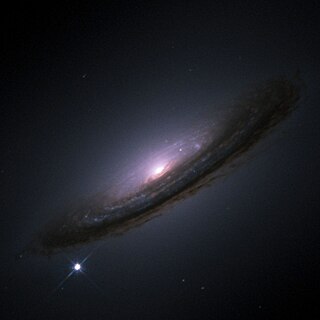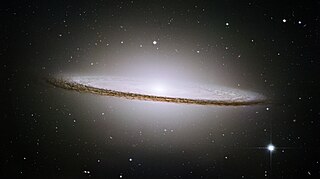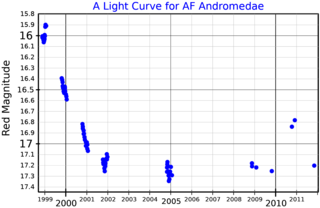
Cygnus is a northern constellation on the plane of the Milky Way, deriving its name from the Latinized Greek word for swan. Cygnus is one of the most recognizable constellations of the northern summer and autumn, and it features a prominent asterism known as the Northern Cross. Cygnus was among the 48 constellations listed by the 2nd century astronomer Ptolemy, and it remains one of the 88 modern constellations.

A supernova is a powerful and luminous explosion of a star. A supernova occurs during the last evolutionary stages of a massive star, or when a white dwarf is triggered into runaway nuclear fusion. The original object, called the progenitor, either collapses to a neutron star or black hole, or is completely destroyed to form a diffuse nebula. The peak optical luminosity of a supernova can be comparable to that of an entire galaxy before fading over several weeks or months.

Wolf–Rayet stars, often abbreviated as WR stars, are a rare heterogeneous set of stars with unusual spectra showing prominent broad emission lines of ionised helium and highly ionised nitrogen or carbon. The spectra indicate very high surface enhancement of heavy elements, depletion of hydrogen, and strong stellar winds. The surface temperatures of known Wolf–Rayet stars range from 20,000 K to around 210,000 K, hotter than almost all other kinds of stars. They were previously called W-type stars referring to their spectral classification.

In the fields of Big Bang theory and cosmology, reionization is the process that caused electrically neutral atoms in the universe to reionize after the lapse of the "dark ages".

A dwarf galaxy is a small galaxy composed of about 1000 up to several billion stars, as compared to the Milky Way's 200–400 billion stars. The Large Magellanic Cloud, which closely orbits the Milky Way and contains over 30 billion stars, is sometimes classified as a dwarf galaxy; others consider it a full-fledged galaxy. Dwarf galaxies' formation and activity are thought to be heavily influenced by interactions with larger galaxies. Astronomers identify numerous types of dwarf galaxies, based on their shape and composition.

NGC 3603 is a nebula situated in the Carina–Sagittarius Arm of the Milky Way around 20,000 light-years away from the Solar System. It is a massive H II region containing a very compact open cluster HD 97950.

Luminous blue variables (LBVs) are massive evolved stars that show unpredictable and sometimes dramatic variations in their spectra and brightness. They are also known as S Doradus variables after S Doradus, one of the brightest stars of the Large Magellanic Cloud. They are considered to be rare.
The Milky Way has several smaller galaxies gravitationally bound to it, as part of the Milky Way subgroup, which is part of the local galaxy cluster, the Local Group.

The Boötes Dwarf Galaxy is a galaxy discovered in 2006, which appears faint, with a luminosity of 100,000 L☉ and an absolute magnitude of –5.8. It lies about 197,000 light-years away in the constellation Boötes. This dwarf spheroidal galaxy appears to be tidally disrupted by the Milky Way Galaxy, which it orbits, and has two stellar tails that cross over to form a cross. Tidally disrupted galaxies usually only form one tail. The galaxy appears to be significantly elongated, with an ellipticity of ε = 0.68 ± 0.15.

A low-ionization nuclear emission-line region (LINER) is a type of galactic nucleus that is defined by its spectral line emission. The spectra typically include line emission from weakly ionized or neutral atoms, such as O, O+, N+, and S+. Conversely, the spectral line emission from strongly ionized atoms, such as O++, Ne++, and He+, is relatively weak. The class of galactic nuclei was first identified by Timothy Heckman in the third of a series of papers on the spectra of galactic nuclei that were published in 1980.

NGC 2366 is a Magellanic barred irregular dwarf galaxy located in the constellation Camelopardalis.

HL Tau 76 is a variable white dwarf star of the DAV type. It was observed by G. Haro and W. J. Luyten in 1961, and was the first variable white dwarf discovered when, in 1968, Arlo U. Landolt found that it varied in brightness with a period of approximately 749.5 seconds, or 12.5 minutes. Like other DAV white dwarfs, its variability arises from non-radial gravity wave pulsations within itself., § 7. Later observation and analysis has found HL Tau 76 to pulsate in over 40 independent vibrational modes, with periods between 380 seconds and 1390 seconds.

A hypergiant (luminosity class 0 or Ia+) is a very rare type of star that has an extremely high luminosity, mass, size and mass loss because of its extreme stellar winds. The term hypergiant is defined as luminosity class 0 (zero) in the MKK system. However, this is rarely seen in literature or in published spectral classifications, except for specific well-defined groups such as the yellow hypergiants, RSG (red supergiants), or blue B(e) supergiants with emission spectra. More commonly, hypergiants are classed as Ia-0 or Ia+, but red supergiants are rarely assigned these spectral classifications. Astronomers are interested in these stars because they relate to understanding stellar evolution, especially star formation, stability, and their expected demise as supernovae. A common example of a hypergiant is UY Scuti, although being a supergiant UY Scuti is considered a hypergiant by some people.

A Pea galaxy, also referred to as a Pea or Green Pea, might be a type of luminous blue compact galaxy that is undergoing very high rates of star formation. Pea galaxies are so-named because of their small size and greenish appearance in the images taken by the Sloan Digital Sky Survey (SDSS).

Tololo 1247-232 is a small galaxy at a distance of 652 million light-years. It is situated in the southern equatorial constellation of Hydra. Visually, Tol 1247 appears to be an irregular or possibly a barred spiral galaxy. Tol 1247 is named after the surveys that were carried at the Cerro Tololo Inter-American Observatory (CTIO), the first of which was in 1976. It is one of nine galaxies in the local universe known to emit Lyman continuum photons.

Haro 11 (H11) is a small galaxy at a distance of 300,000,000 light-years (redshift z=0.020598). It is situated in the southern constellation of Sculptor. Visually, it appears to be an irregular galaxy, as the ESO image to the right shows. H11 is named after Guillermo Haro, a Mexican astronomer who first included it in a study published in 1956 about blue galaxies. H11 is a starburst galaxy that has 'super star clusters' within it and is one of nine galaxies in the local universe known to emit Lyman continuum photons (LyC).

NGC 1614 is the New General Catalogue identifier for a spiral galaxy in the equatorial constellation of Eridanus. It was discovered on December 29, 1885 by American astronomer Lewis Swift, who described it in a shorthand notation as: pretty faint, small, round, a little brighter middle. The nebula was then catalogued by Danish-Irish astronomer J. L. E. Drayer in 1888. When direct photography became available, it was noted that this galaxy displayed some conspicuous peculiarities. American astronomer Halton Arp included it in his 1966 Atlas of Peculiar Galaxies. In 1971, Swiss astronomer Fritz Zwicky described it as a "blue post-eruptive galaxy, compact patchy core, spiral plumes, long blue jet SSW".

AF Andromedae is a luminous blue variable (LBV), a type of variable star. The star is one of the most luminous variables in M31, the Andromeda Galaxy.

NGC 4670 is a blue compact galaxy in the constellation Coma Berenices. The galaxy lies about 60 million light years away from Earth, which means, given its apparent dimensions, that NGC 4670 is approximately 25,000 light years across. It was discovered by William Herschel on April 6, 1785.





















